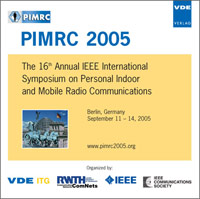On the Implications of Layered Space-Time Multiuser Detection on the Design of MAC Protocols for Ad Hoc Networks
Conference: PIMRC 2005 - 16th Annual IEEE International Symposium on Personal Indoor and Mobile Radio Communications
09/11/2005 - 09/14/2005 at Berlin, Germany
Proceedings: PIMRC 2005
Pages: 7Language: englishTyp: PDF
Personal VDE Members are entitled to a 10% discount on this title
Authors:
Casari, Paolo; Levorato, Marco; Zorzi, Michele (DEI, University of Padova, Via G. Gradenigo, 6/B, 35131 Padova (PD), Italy)
Zorzi, Michele (Department of ECE, University of California at San Diego, 9500 Gilman Drive, La Jolla, CA 02903-0407, USA)
Abstract:
In this paper, we shed some light on the implications that using a recently proposed layered space-time multiuser detection technique has on MAC protocol design for ad hoc networks with multiple antennas. From this point of view, our work relates to both physical layer and network layer studies. In fact, on the one hand physical layer aspects are important to characterize the behavior at the receiver, especially in terms of Bit and Packet Error Rates, but are rarely considered in conjunction with networking scenarios; on the other hand, networking aspects are typically studied using drastically simplified physical layer models that, while allowing easier networking analysis, are often too restrictive or unrealistic. Also, this disconnect between physical and networking layer studies may severely limit the possibilities for cross-layer optimization, which appears to be the right approach for efficient wireless network design. Our paper is then an effort to establish some connection between the "physical" and "network" approaches, highlighting some interesting capabilities that ad hoc networks with multiple antennas are endowed by the use of multiuser detection.


